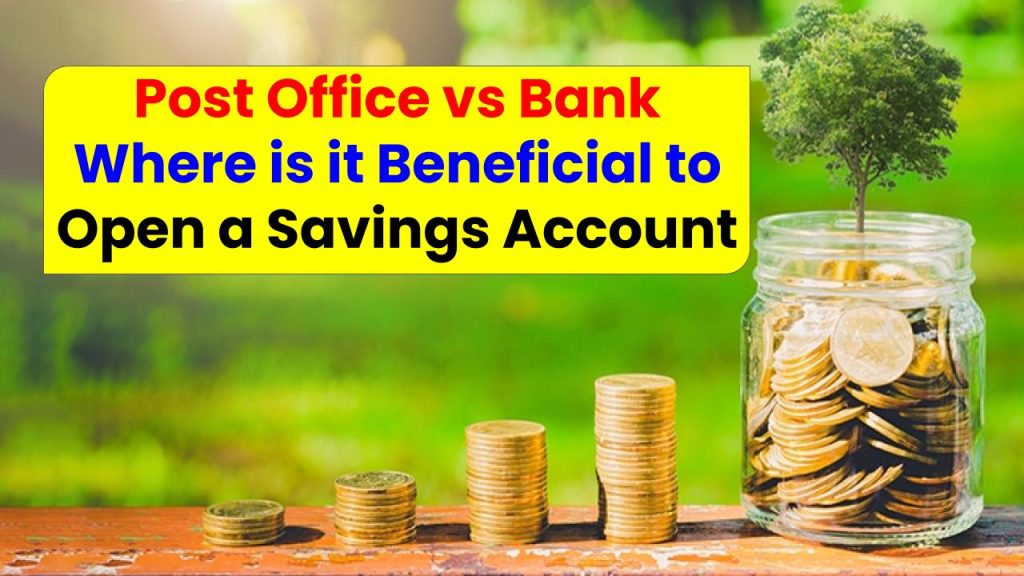
When deciding where to open a savings account, many Indians often find themselves weighing between a Post Office Savings Account and a Bank Savings Account. Both options are backed by the government and considered safe, but which one gives you better interest? And which is more convenient or rewarding in the long run?
Post Office vs Bank Savings Accounts
| Feature | Post Office Savings Account | Bank Savings Account |
|---|---|---|
| Interest Rate (as of April 2025) | 4.0% per annum (fixed) | Ranges from 2.70% to 7.25%, varies by bank and balance |
| Minimum Balance Requirement | ₹500 | ₹0 to ₹10,000 (varies by bank) |
| Tax on Interest | Taxable, no TDS | Taxable, TDS may apply if interest exceeds ₹40,000 |
| Deposit Insurance | 100% backed by Govt. of India | Covered by DICGC up to ₹5 lakh |
| Accessibility | Limited ATM/digital services | Extensive online/mobile banking |
| Best For | Conservative savers, rural investors | Professionals, digital-first users |
If your priority is higher interest earnings, many private and small finance banks offer better rates than the post office. But if you’re looking for trust, stability, and a government-backed scheme, the Post Office Savings Account remains a solid choice.
What is a Post Office Savings Account?
A Post Office Savings Account is a government-backed deposit scheme offered by the India Post under its vast network of over 1.5 lakh branches. It is one of the oldest and most trusted savings options in India.
Key Features:
- Fixed interest rate of 4.0% per annum (as of April 2025)
- Minimum balance requirement of just ₹500
- Account can be opened with or without a chequebook
- Ideal for people living in rural and semi-urban areas
- Account is fully secured by the Government of India
Tip: A post office account is a great option for senior citizens, homemakers, and individuals without access to formal banking.
see also: Savings vs Investing: Do You Know the Difference Between the Two?
What is a Bank Savings Account?
A bank savings account is a deposit account provided by public or private sector banks where you can store your money securely while earning interest on your balance.
Features to Know:
- Interest rates vary by bank and often by balance slab
- Many banks offer digital-first services like mobile banking, UPI, and ATM access
- Banks are regulated by RBI and deposits are insured by DICGC up to ₹5 lakh
- Ideal for salaried individuals, businesses, and frequent transactors
Comparing Interest Rates – Who Pays More?
This is the heart of the debate. Let’s break down who’s offering higher interest in 2025.
Post Office Savings Account
- Fixed 4.0% per annum, unchanged for several quarters
- Interest is credited annually but calculated monthly
Bank Savings Accounts (Top Banks as of April 2025):
| Bank | Balance | Interest Rate |
|---|---|---|
| SBI | Up to ₹10 crore | 2.70% p.a. |
| HDFC Bank | Below ₹50 lakh | 3.00% p.a. |
| ICICI Bank | Below ₹50 lakh | 3.00% p.a. |
| IDFC FIRST Bank | ₹5 lakh – ₹100 crore | Up to 7.25% p.a. |
| Axis Bank | ₹50 lakh+ | Up to 4.25% p.a. |
| PNB | ₹10 lakh – ₹100 crore | 2.75% – 3.00% p.a. |
Which Account is Better for You?
If You Are a Conservative Saver:
Choose Post Office Savings Account. It offers:
- Guaranteed interest
- Government security
- Better suited for those not comfortable with digital banking
If You Are a Professional or Business Owner:
Go with a high-interest bank account like:
- IDFC FIRST Bank (up to 7.25%)
- AU Small Finance Bank (up to 7%)
These banks offer:
- Higher returns
- 24/7 access via apps and ATMs
- Auto sweep facilities (FD-linked savings)
Practical Example – Who Earns More on ₹1 Lakh?
Let’s say you deposit ₹1,00,000 and keep it untouched for 1 year.
| Institution | Interest Rate | Earnings in 1 Year |
|---|---|---|
| Post Office | 4.0% | ₹4,000 |
| SBI | 2.70% | ₹2,700 |
| HDFC/ICICI | 3.00% | ₹3,000 |
| IDFC FIRST Bank | 7.25% | ₹7,250 |
Clearly, newer private banks offer significantly higher returns for higher balances.
Other Factors to Consider Beyond Interest
1. Digital Banking
Most private banks now offer fully digital onboarding, UPI, and zero balance options. Post Office still lacks full digital functionality for savings accounts.
2. Taxation
- Interest from both accounts is fully taxable under “Income from Other Sources”
- Banks deduct TDS if yearly interest exceeds ₹40,000 (₹50,000 for senior citizens)
- Post Office does not deduct TDS, but you still need to declare the interest while filing ITR
3. Joint & Minor Accounts
Both banks and post offices allow:
- Joint accounts
- Minor accounts under guardianship
- Nomination facilities
How to Open a Savings Account (Step-by-Step Guide)
Post Office Account Opening
- Visit your nearest post office branch
- Fill up Form A for savings account
- Submit Aadhaar, PAN, and address proof
- Deposit a minimum of ₹500
- Account is activated instantly or within 1–2 days
Bank Account Opening
- Choose a bank (online or offline)
- For online: Visit the bank’s app/website and complete video KYC
- Upload PAN, Aadhaar, and selfie
- Some banks allow zero balance accounts, others require ₹5,000–₹10,000 minimum
see also: SBI Special Fixed Deposit: Get More Interest in This Scheme
Post Office vs Bank Savings Accounts FAQs
Q1. Which is safer – bank or post office savings account?
Both are safe and regulated. Post office accounts are 100% backed by the Government, while banks offer insurance up to ₹5 lakh through DICGC.
Q2. Can I have both post office and bank savings accounts?
Yes. You can hold multiple savings accounts, but remember to declare interest income in your ITR.
Q3. Are small finance banks safe for higher interest rates?
Yes, if they are RBI-licensed. However, ensure you stay within the ₹5 lakh insurance limit for safety.
Q4. Can I convert my post office account to digital?
India Post is gradually rolling out Internet and mobile banking, but availability still depends on your region.
Q5. Which is better for senior citizens?
Post Office accounts offer fixed returns and no TDS deduction, making them ideal for many senior citizens.











